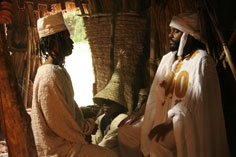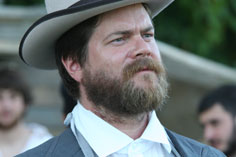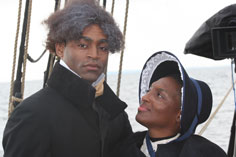WBGH documentary details African prince’s Miss. enslavement
The stories and images are always arresting: Africans brought to the Americas during the four brutal centuries of the slave trade. Torn from their families. Sold as disposable commodities. Herded through tiny portals that led only to the blue horizon beyond, never again to set sight on their homes.
“Prince Among Slaves,” a new documentary airing on WGBH that debuted this week and re-airs Sunday morning in honor of Black History Month, traces the extraordinary story of an 18th-century West African prince as he was captured into servitude as a young man.
Named the best documentary at the 2007 American Black Film Festival, the film tells the story of Abdul Rahman, a Muslim prince in Futa Jalon, a region in Western Africa that is now part of Guinea. Rahman’s life of learning and leadership was disrupted in 1788, when he was captured and sold to slave traders on an English ship.
“They sold me,” he says in a solemn voiceover that opens the film, “for two flasks of powder, some muskets, eight twists of tobacco and two bottles of rum.”
Actor and hip-hop artist Mos Def narrates Rahman’s plight as he spends eight torturous months crossing the Atlantic Ocean, is purchased by a tobacco plantation owner in Natchez, Miss., and spends the next 40 years struggling to buy his freedom.
Rahman’s journey is related through a mixture of feature film-style reenactments directed by Andrea Kalin and Emmy Award-winner Bill Duke, contemporary artwork, archival materials and on-camera interviews with scholars and experts.
Associate producer Robyn Coblyn said that the project took shape during a conversation about the events of Sept. 11, 2001, that led to questions about “what the lives of Muslim Americans were like … who were the first Muslims in America and how did they get here?”
Rahman’s religious beliefs and his life as a captive in Mississippi offered another lens through which to view the experience of slavery and its attendant effects, she added.
“This is the story of a man, who through his faith and hope, was able to sustain life through these 40 years of slavery,” said Coblyn.
The prince’s level of education — he spoke four languages, including Arabic, and was schooled in astronomy and mathematics — and his affluence in his home country presented a stark contrast with the life of Thomas Foster, the poor, nearly illiterate planter who became his master, Coblyn said.
Reenactments depict the frontier of Mississippi as a hardscrabble place where life depended entirely on the production and trade of viable crops. When Foster purchased Rahman, he owned a small plot of land on which he struggled to grow tobacco. But with Rahman’s knowledge of agriculture producing plentiful crops from the soil, Foster soon prospered. His property expanded to 1,700 acres and came to include 40 adult Africans working on the plantation, all of whom he entrusted to Rahman.
“Rahman made himself indispensable on the family farm,” explained historian Terry Alford, who authored the book “Prince Among Slaves,” on which the documentary is based. “He was no made overseer; he became the de facto overseer.”
Ironically, Rahman’s skills proved to be the greatest hurdle to his freedom. Foster refused to let him go until he was too old to be of any further use to the plantation, at which point Rahman had recruited President John Quincy Adams to advocate for his release.
In a phone interview, Alford pointed out that Rahman’s story had curious links to Boston, which he visited upon obtaining his freedom in 1828.
“The year he got freed, he was making a tour in the eastern U.S. to raise money to buy his children out of slavery and … Boston was the most receptive to him,” Alford said, adding that a scene in the documentary recreates a banquet held by leaders of the city’s free black community in Rahman’s honor prior to the prince’s voyage back to Africa, where his royal status was restored.
An item about the dinner in the Oct. 24, 1828 edition of the black Freedom’s Journal newspaper read: “Prince Abduhl Rahhaman of Futa Jalon was enslaved for forty years in the United States. Before his return to Africa, he was feted in Boston with a dinner in which many black Boston community leaders participated, including David Walker, John T. Hilton, Coffin Pitts, Thomas Cole and Domingo Williams.”
Alford also highlighted contemporary parallels to Rahman’s story. The prince obtained his freedom with help from John Quincy Adams in the same year that Adams was embroiled in a presidential campaign against Andrew Jackson. In an election that revolved heavily around issues of race, Adams’ assistance in helping Rahman obtain his freedom quickly became a firing point for Jackson, who warned voters that Adams would free all the slaves, inciting rebellion in the South.
Coblyn also stressed the importance of correlating historical documentaries with current events, emphasizing the importance of exchanging ideas not just about race, but also religion.
“The hope is that people will translate what they see in the film from history into a dialogue that can prevent or change the way things are going now,” she said.
For airdates, times and additional information on “Prince Among Slaves” and other Black History Month programs running on WGBH, visit www.wgbh.org.
|
| Prince Abdul Rahman (left) receives a military commission from his father in this reenactment scene from the documentary “Prince Among Slaves,” airing on WGBH. “Prince” tells the true story of Rahman, a West African prince enslaved for 40 years in Mississippi before achieving freedom, fame and a return to his homeland. (Wanakhavi Wakhisi photo) |
|
(top) Rahman’s eventual master Thomas Foster, seen here in a reenactment scene from “Prince Among Slaves,” was a poor, nearly illiterate planter struggling on the harsh Mississippi frontier.
(bottom) In this reenactment scene from the documentary “Prince Among Slaves,” Rahman and his wife, Isabella, return to Africa after he attains his freedom. Prior to his voyage home, the prince was feted by a number of prominent members of Boston’s free black community at a banquet in his honor, an event recreated in the film. (Wanakhavi Wakhisi photos)
|
|





